Hartismere, Suffolk
Up to 1834
The parish of Eye had a workhouse from 1726.
In 1779, the Suffolk Hundreds of Hartismere, Hoxne and Thredling were incorporated under a local Act of Parliament for the better Relief and Employment of the Poor, within the several Hundreds of Hartsmere, Hoxne, and Thredling, in the County of Suffolk (19 Geo.3 c.13). However, the Incorporation never raised the £16,000 required for the erection of a House of Industry. Several member parishes did however operate workhouses of their own including Eye, Mendlesham, Occold, Palgrave, Redlingfield, Westhorpe, Wetheringsett and Wortham.
Number 2, Old Market Street, in Mendlesham originates from the 15th century and was once a school to which was added a workhouse in 1726. Number 4, which largely dates from 1873, was once a schoolmaster's house and incorporates the remains of the workhouse.
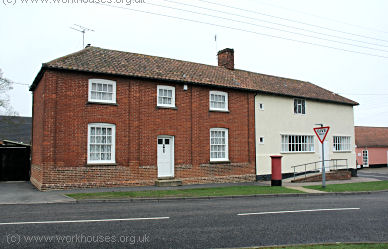
2-4 Old Market Street, Mendlesham, 2005
© Peter Higginbotham.
A house on The Street in Occold was used as the parish workhouse in the early 1800s.
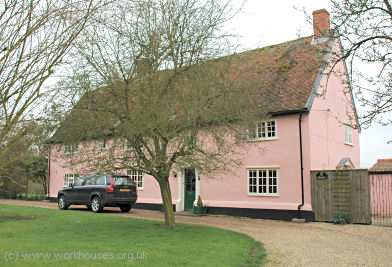
Occold former parish workhouse, 2005
© Peter Higginbotham.
A house standing opposite the parish church in Palgrave is a former guildhall, workhouse, and almshouses, originally dating from 1510.
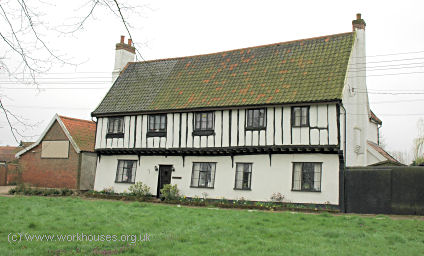
Palgrave former parish workhouse, 2005
© Peter Higginbotham.
A house on Horham Road in Redlingfield was at on time the parish workhouse.
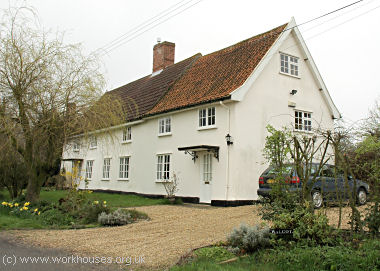
Redlingfield former parish workhouse, 2005
© Peter Higginbotham.
Town Yard Cottages in Westhorpe were once employed as parish poorhouses.
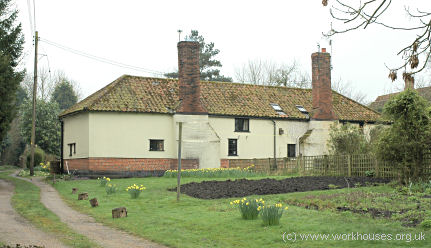
Westhorpe former parish workhouse, 2005
© Peter Higginbotham.
A house on Church Street in Wetheringsett is said to have been a parish poorhouse in the 17th century.
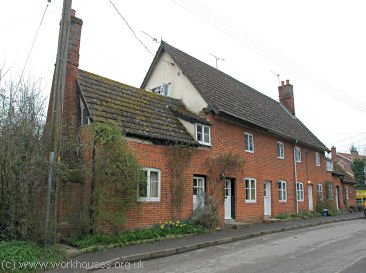
Wetheringsett former parish workhouse, 2005
© Peter Higginbotham.
After 1834
The Hartismere Poor Law Union formally came into being on 1st September 1835. Its operation was overseen by an elected Board of Guardians, 37 in number, representing its 32 constituent parishes as listed below (figures in brackets indicate numbers of Guardians if more than one):
County of Suffolk: Aspall, Bacton, Bottesdale [Botesdale], Braiseworth, Broome [Brome], Burgate, Cotton, Eye (3), Finningham, Gislingham, Mellis, Mendlesham (2), Oakley, Occold, Palgrave, Redgrave, Redlingfield, Rickenhall [Rickinghall] Superior, Rishangles, Stoke Ash, Sturston [Stuston], Thorndon All Saints, Thornham Magna, Thornham Parva, Thrandeston, Thwaite, Westhorpe, Wetheringsett cum Brockford (2), Wickham Skeith, Wortham (2), Wyverstone, Yaxley.
The population falling within the Union at the 1831 census had been 17,871 — with parishes ranging in size from from Aspall (population 126) to Eye (2,313). The average annual poor-rate expenditure for the period 1833-35 had been £19,212 or £1.1s.6d. per head of the population.
The new Hartismere Poor Law Union took over two existing parish workhouses at Eye and at Wortham, the latter being used to house children and the aged and infirm. The Poor Law Commissioners authorised the major expenditure of £8,274 on the erection of a new building for 300 inmates although it is not clear where (or if) this project was carried out.
The Eye Workhouse
The Eye workhouse was located at Castle Hill and dated from the late 18th century. According to White's Directory of 1855, the workhouse was considerably enlarged in 1854 with £4,000 being spent on a new building to house 200 adult inmates. The buildings at Eye featured a long main block facing to the south-east with a wing to its rear separating two exercise yards. Various other irregularly placed blocks lay to the north-west. The workhouse location and layout are shown on the 1904 map below.
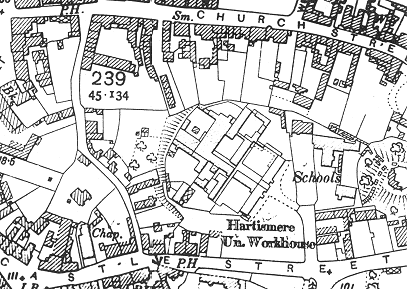
Hartismere workhouse site, 1904.
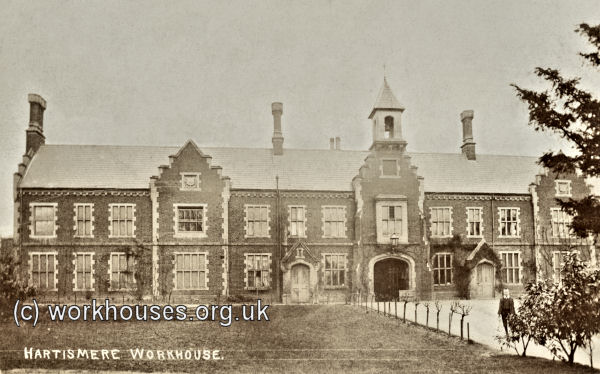
Hartismere Union workhouse, Eye, c.1900.
© Peter Higginbotham.
On 16th June, 1838, the Times newspaper carried an article alleging scandalous conditions in the Eye workhouse. The inmates, it was claimed, were so badly fed that they had resorted to eating mice, potato peelings, and a poultice. An investigation by the Poor Law Commissioners was unable to substantiate any of the allegations.
In 1907, Hartismere was merged with the neighbouring Hoxne Union to create a new Hartismere and Hoxne Poor Law Union.
The Eye workhouse is understood to have been demolished in the 1970s and housing now occupies the site.
The Wortham School
The former parish workhouse at Wortham initially housed the aged and infirm and children. After a few years was just used to accommodated children, up to 85 in number, with boys being employed in gardening and spade husbandry, and the girls in sewing and general domestic work fitting them for service.
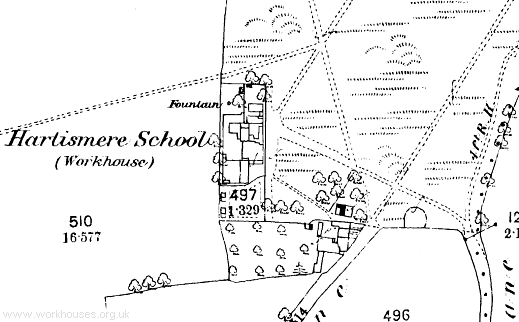
Hartismere Union school site, Wortham, 1886.
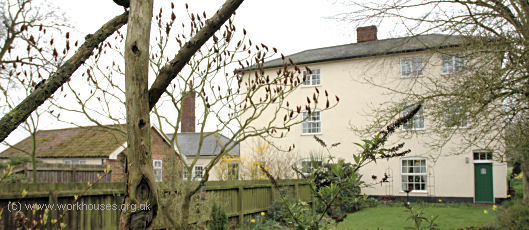
Wortham former workhouse school from the north, 2005
© Peter Higginbotham.
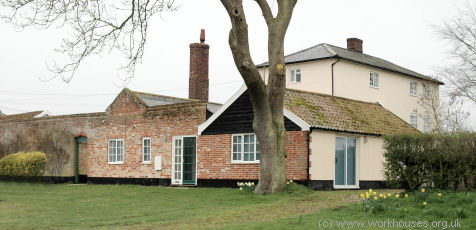
Wortham former workhouse school from the north-east, 2005
© Peter Higginbotham.
In 1880, a report by Local Government Board Inspector, Mr Bowyer, found much to praise in the school:
The school was closed in around 1898.
Children's Home
After the Wortham school was closed, the Hartismere Union opened a children's home at Wilton House, 50 Castle Street, Eye. In 1908, the home could accommodate 30 children and Alice Reynolds was Matron. By 1924, the home had been renamed Willow House and the children were in the charge of A. Mansbridge.
The Hartismere and Hoxne Union Infirmary, Eye
After the Hartismere and Hoxne amalgamated, the new union erected a poor law infirmary on Castleton's Way in Eye in 1915-16. The new infirmary had 160 beds and was designed by Herbert J Green of Norwich and cost around £17,000. It opened in around October 1916. Its location and layout are shown on the 1925 map below.
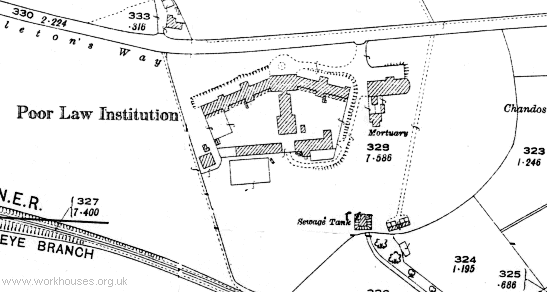
Eye Hospital workhouse site, 1925.
The main block had a "half-butterfly" layout with an administration block at the centre and ward blocks to each side.
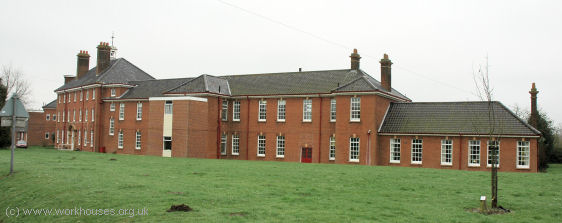
Eye Infirmary main building from the north-west, 2005
© Peter Higginbotham.
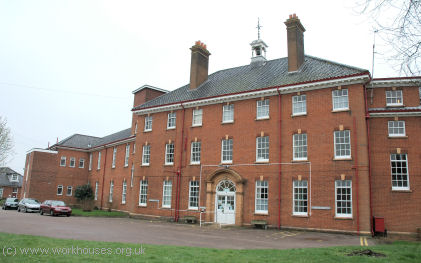
Eye Infirmary administration block, 2005
© Peter Higginbotham.
To the rear of the administration block were placed the dining-hall with chapel above and kitchens to its rear. A separate laundry and boiler room lay to the south.
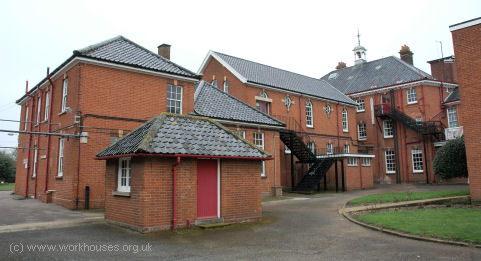
Eye Infirmary kitchen/dining-hall/chapel, 2005
© Peter Higginbotham.
A separate single-storey building at the east contained the Guardians' board-room, a committee room, clerk's office, porter's lodge and receiving wards. A mortuary lay to its rear.

Eye Infirmary board-room and reception block form the south-east, 2005
© Peter Higginbotham.
The former union infirmary is now Hartismere Hospital.
Staff
Inmates
Records
Note: many repositories impose a closure period of up to 100 years for records identifying individuals. Before travelling a long distance, always check that the records you want to consult will be available.
- Suffolk Archives, The Hold, 131 Fore Street, Ipswich, Suffolk IP4 1LR. Few records survive — holdings include: Guardians' minute books (1907-1930); Children's Home creed register (1910-1930); etc.
Bibliography
- Ninth Annual Report of the Local Government Board, 1880.
Links
- None.
Unless otherwise indicated, this page () is copyright Peter Higginbotham. Contents may not be reproduced without permission.


